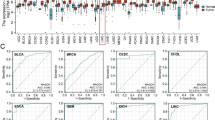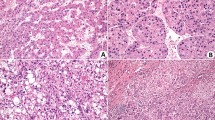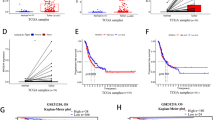Summary
MAGE gene family encodes peptides recognized by autologous cytotoxic T lymphocytes in a major histocompatibility complex (MHC) class-I restricted fashion. In the present study, we have performed reverse-transcription polymerase chain reaction (RT-PCR) for the genes, as well as immunohistochemical analysis and Western blotting of MAGE-1 and -3 proteins in 33 surgically resected hepatocellular carcinomas (HCCs). MAGE-1 and -3 mRNAs were constitutively expressed exclusively in 78 and 42% of HCCs respectively. On immunohistochemistry with monoclonal antibodies, 77B for MAGE-1 and 57B for MAGE-3, MAGE-1 and -3 proteins were recognized in cytoplasm of only six among 33 (18%) and two of 29 HCCs (7%) respectively. The distribution pattern was mostly focal in HCC nodules. By contrast, the Western blot analysis revealed that the MAGE-1 (46 kDa) and -3 proteins (48 kDa) were expressed in 80 and 60% of 15 HCCs examined respectively. The proteins of MAGE-1 and -3 were also expressed exclusively in HCCs regardless of the histological grading and clinical staging. Our results indicate that the detection of the genes by RT-PCR or the proteins by Western blotting is useful for differentiating early HCCs from non-cancerous lesions, and that the peptides derived from MAGE-1 and -3 proteins might be suitable targets for immunotherapy of human HCC.
Similar content being viewed by others
Article PDF
Change history
16 November 2011
This paper was modified 12 months after initial publication to switch to Creative Commons licence terms, as noted at publication
References
Bakker, AB, Marland, G, de Boer, AJ, Huijbens, RJ, Danen, EH, Adema, GJ & Figdor, CG (1995). Generation of antimelanoma cytotoxic T lymphocytes from healthy donors after presentation of melanoma-associated antigen-derived epitopes by dendritic cells in vitro. Cancer Res 55: 5330–5334.
Carrel, S, Schreyer, M, Spagnoli, GC, Cerottini, JC & Rimodi, D (1996). Monoclonal antibodies against recombinant-MAGE-1 protein identify a cross-reacting 72-kDa antigen which is co-expressed with MAGE-1 protein in melanoma cells. Int J Cancer 67: 417–422.
Celis, E, Fikes, J, Wentworth, P, Sidney, J, Southwood, S, Maewal, A, Del Guercio, MF & Livingston, B (1994). Identification of potential CTL epitopes of tumor-associated antigen MAGE-1 for five common HLA-A alleles. Mol Immunol 31: 1423–1430.
Chen, Y-T, Stockert, E, Chen, Y, Garin-Chesa, P, Rettig, WJ, van der Bruggen, P, Boon, T & Old, LJ (1994). Identification of the MAGE-1 product by monoclonal and polyclonal antibodies. Proc Natl Acad Sci USA 91: 1004–1008.
Corrias, MV, Scaruffi, P, Occhino, M, De Bernardi, B, Tonini, GP & Pistoia, V (1996). Expression of MAGE-1, MAGE-3 and MART-1 genes in neuroblastoma. Int J Cancer 69: 403–407.
De Plaen, E, Arden, K, Traversari, C, Gaforio, JJ, Szikora, JP, De Smet, C, Brasseur, F, van der Bruggen, P, Lethe, B & Lurquin, C et al (1994). Structure, chromosomal localization, and expression of 12 genes of the MAGE family. Immunogenetics 40: 360–369.
Eura, M, Chikamatsu, K, Ogi, K, Nakano, K, Masuyama, K & Ishikawa, T (1995a). Expression of MAGE-1, -2, and -3 by human maxillary carcinoma. Anticancer Res 15: 55–59.
Eura, M, Ogi, K, Chikamatsu, K, Lee, KD, Nakano, K, Masuyama, K, Itoh, K & Ishikawa, T (1995b). Expression of the MAGE gene family in human head-and-neck squamous-cell carcinomas. Int J Cancer 64: 304–308.
Fleischhauer, K, Tanzarella, S, Russo, V, Sensi, ML, van der Burggen, P, Bordignon, C & Traversari, C (1997). Functional heterogeneity of HLA-A*02 subtypes revealed by presentation of a MAGE-3-encoded peptide to cytotoxic T cell clones. J Immunol 159: 2513–2521.
Gaugler, B, Van den Eynde, B, Van der Burggen, P, Romero, P, Gaforio, JJ, De Plaen, E, Lethe, B, Brasseur, F & Boon, T (1994). Human gene MAGE-3 codes for an antigen recognized on a melanoma by autologous cytolytic T lymphocytes. J Exp Med 179: 921–930.
Gudat, F, Zuber, M, Durmuller, U, Kocher, T, Schaefer, C, Noppen, C & Spagnoli, GC (1996). The tumor-associated antigen MAGE-1 is detectable in formalin-fixed paraffin sections of malignant melanoma. Virchows Arch 429: 77–81.
Gunther, FL, Hofbauer, L, Schaefer, C, Noppen, C, Boni, R, Kamarashev, J, Nestlé, FO, Spagnoli, GC & Dummer, R (1997). MAGE-3 immunoreactivity in formalin-fixed paraffin-embedded primary and metastatic melanoma. Am J Pathol 151: 1549–1553.
Hu, X, Chakraborty, NG, Sporn, JR, Kurtzman, SH, Ergin, MT & Mukherji, B (1996). Enhancement of cytolytic T lymphocyte precursor frequency in melanoma patients following immunization with the MAGE-1 peptide loaded antigen presenting cell-based vaccine. Cancer Res 56: 2479–2483.
Inoue, H, Mori, M, Honda, M, Li, J, Shibuta, K, Mimori, K, Ueo, H & Akiyoshi, T (1995). The expression of tumor-rejection antigen ‘MAGE’ genes in human gastric carcinoma. Gastroenterology 109: 1522–1525.
Jurk, M, Kremmer, E, Schwarz, U, Forster, R & Winnacker, EL (1998). MAGE-11 protein is highly conserved in higher organisms and located predominantly in the nucleus. Int J Cancer 75: 762–766.
Kocker, T, Schultz-Thater, E, Gudat, F, Schaefer, C, Casorati, G, Juretic, A, Willimann, T, Harder, F, Heberer, M & Spagnoli, GC (1995). Identification and intracellular localization of MAGE-3 gene product. Cancer Res 55: 2236–2239.
Lee, KD, Eura, M, Ogi, K, Nakano, K, Chikamatsu, K, Masuyama, K & Ishikawa, K (1996). Expression of the MAGE-1, -2, -3, -4, and -6 genes in the non-squamous cell carcinoma lesions of the head and neck. Acta Otolaryngol 116: 633–639.
Liver Cancer Study Group of Japan (1989). The general rules for the clinical and pathological study of primary liver cancer. Jpn J Surg 19: 98–129.
Lucas, S, De Smet, C, Arden, KC, Viars, CS, Lethe, B, Lurquin, C & Boon, T (1998). Identification of a new MAGE gene with tumor-specific expression by representational difference analysis. Cancer Res 58: 743–752.
Lurquin, C, De Smet, C, Brasseur, F, Muscatelli, F, Martelange, V, De Plaen, E, Brasseur, R, Monaco, AP & Boon, T (1997). Two members of the human MAGE B gene family located in Xp21.3 are expressed in tumors of various histological origins. Genomics 46: 397–408.
Marchand, M, Brasseur, F, van der Bruggen, P, Coulie, P & Boon, T (1993). Perspectives for immunization of HLA-A1 patients carrying a malignant melanoma expressing gene MAGE-1. Dermatology 186: 278–280.
Marincola, FM, Rivoltini, L, Salagaller, ML, Player, M & Rosenberg, SA (1996). Differential anti-MART-1/MelanA CTL activity in peripheral blood of HLA-A2 melanoma patients in comparison to healthy donors: evidence of in vivo priminig by tumor cells. J Immunother Emphasis Tumor Immunol 19: 266–277.
Mori, M, Inoue, H, Mimori, K, Shibuta, K, Baba, K, Nakashima, H, Haraguchi, M, Tsuhi, K, Ueo, H, Barnard, GF & Akiyoshi, T (1996). Expression of MAGE genes in human colorectal carcinoma. Ann Surg 224: 183–188.
Muramoto, T (1997). Detection of MAGE-1 tumor antigen in brain tumor. Kurume Med J 44: 43–51.
Nestlé, FO, Alijagic, S, Gilliet, M, Sun, Y, Grabbe, S, Dummer, R, Burg, G & Schadendorf, D (1998). Vaccination of melanoma patients with peptide- or tumor lysate-pulsed dendritic cells. Nature Med 4: 328–332.
Okuda, K (1992). Hepatocellular carcinoma: recent progress. Hepatology 15: 948–963.
Patard, JJ, Brasseur, F, Gil-Diez, S, Radvanyi, F, Marchand, M, Francois, P, Abi-Aad, A, Van Cangh, P, Abbou, CC & Chopin, D (1995). Expression of MAGE genes in transitional-cell carcinomas of the urinary bladder. Int J Cancer 64: 60–64.
Sudo, T, Kuramoto, T, Komiya, S, Inoue, A & Itoh, K (1997). Expression of MAGE genes in osteosarcoma. J Orthop Res 15: 128–132.
Toh, Y, Yamana, H, Schichijo, S, Fujita, H, Tou, U, Sakaguchi, M, Kakegawa, T & Itoh, K (1995). Expression of MAGE-1 gene by esophageal carcinoma. Jpn J Cancer Res 86: 714–717.
Toso, JF, Oei, C, Oshidari, F, Tartaglia, J, Paoletti, E, Lyerly, HK, Talib, S & Weinhold, KJ (1996). MAGE-1-spcific precursor cytotoxic T-lymphocytes present among tumor infiltrating lymphocytes from a patient with breast cancer: characterization and antigen-specific activation. Cancer Res 56: 16–20.
Valomori, D, Lienard, D, Waanders, G, Rimldi, D, Cerottini, JC & Romero, P (1997). Analysis of MAGE-3-specific cytolytic lymphocytes in human leukocyte antigen-A2 melanoma patients. Cancer Res 57: 735–741.
van der Bruggen, P, Szikora, JP, Boel, P, Wildmann, C, Somville, M, Sensi, M & Boon, T (1994). Autologous cytolytic lymphocytes recognized a MAGE-1 nonapeptide on melanomas expressing HLA-Cw*1601. Eur J Immunol 24: 2134–2140.
van der Bruggen, P, Traversari, C, Chomez, P, Lurquin, C, De Plaen, E, Van den Eynde, B, Knuth, A & Boon, T (1991). A gene encoding an antigen recognized by cytolytic lymphocytes on a human melanoma. Science 254: 1643–1647.
Weynants, P, Lethe, B, Brasseur, F, Marchand, M & Boon, T (1994). Expression of mage genes by non-small-cell lung carcinomas. Int J Cancer 56: 826–829.
Yamada, A, Kataoka, A, Shichijo, S, Imai, Y, Nishida, T & Itoh, K (1995). Expression of MAGE-1, MAGE-2, MAGE-3/-6 and MAGE-4a/-4b genes in ovarian tumors. Int J Cancer 64: 388–393.
Yamasaki, S, Okino, T, Chakraborty, NG, Adkisson, WO, Sampieri, A, Padula, SJ, Mauri, F & Mukherji, B (1995). Presentation of synthetic peptide antigen encoded by the MAGE-1 gene by granulocyte/macrophage-colony-stimulating-factor-cultured macrophages from HLA-A1 melanoma patients. Cancer Immunol Immunother 40: 268–271.
Yamashita, N, Ishibashi, H, Hayashida, K, Kudo, J, Takenaka, K, Itoh, K & Niho, Y (1996). High frequency of the MAGE-1 gene expression in hepatocellular carcinoma. Hepatology 24, (6): 1437–1440.
Author information
Authors and Affiliations
Rights and permissions
From twelve months after its original publication, this work is licensed under the Creative Commons Attribution-NonCommercial-Share Alike 3.0 Unported License. To view a copy of this license, visit http://creativecommons.org/licenses/by-nc-sa/3.0/
About this article
Cite this article
Kariyama, K., Higashi, T., Kobayashi, Y. et al. Expression of MAGE-1 and -3 genes and gene products in human hepatocellular carcinoma. Br J Cancer 81, 1080–1087 (1999). https://doi.org/10.1038/sj.bjc.6690810
Received:
Revised:
Accepted:
Published:
Issue date:
DOI: https://doi.org/10.1038/sj.bjc.6690810
Keywords
This article is cited by
-
In vivo enhancement of the MAGE-specific cellular immune response by a recombinant MAGE1-MAGE3-TBHSP70 tumor vaccine
Cancer Cell International (2016)
-
MAGE-3 and MAGE-4 genes as possible markers for early detection of metastases in hepatitis C virus Egyptian patients complicated by hepatocellular carcinoma
Medical Oncology (2012)
-
MAGE-4 gene m-RNA and TGF in blood as potential biochemical markers for HCC in HCV-infected patients
Medical Oncology (2012)
-
Strong CD8+ T-cell responses against tumor-associated antigens prolong the recurrence-free interval after tumor treatment in patients with hepatocellular carcinoma
Journal of Gastroenterology (2010)
-
Expression of cancer–testis antigens in endometrial carcinomas using a tissue microarray
Modern Pathology (2005)



